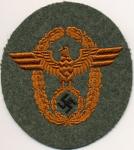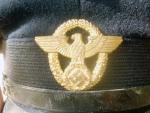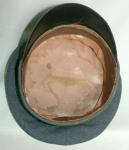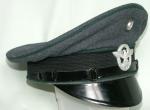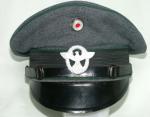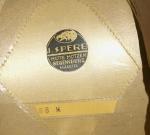-
Posts
344 -
Joined
-
Last visited
-
Days Won
1
Content Type
Profiles
Forums
Blogs
Gallery
Events
Store
Everything posted by W.Unland
-
Hello, Presented here is the uniform of an NCO in the Schutzpolizei d. Gemeinden which were the civil police officers in small municipalities not covered by a Schutzpolizei station. They were hired and uniformed by the municipalities themselves. As they were absorbed into the SchuPo very early on, relics from this organization are very difficult to locate, and are amongst the hardest of the police branches to collect. Their branch color is a deep carmine red. Although the tunic is an NCO and the cap an officer's, or meister's, they still look rather nice together. I still need a pair of piped service trousers if anyone out there has a pair. Thanks for looking. Regards, Bill Unland
-
Dear Rick, Both eagles look OK to me. I see no reason why these could not have been stored at the clothing depot Dachau for use by feldgendarmerie units of the WSS. The 2nd oval was produced without lettering later in the war. That 3 feather is an odd bird. I have one exactly like it. I think that these small ovals don't have room for an embroidered district. Besides, if intended for Feldgendarmerie use they would NOT have had any district or town name in any case. Regards, Bill Unland
-

Prussian Landespolizei
W.Unland replied to W.Unland's topic in Germany: Third Reich: Uniforms, Headwear, Insignia & Equipment
Here is a view of the kokarde on the tschako. It is dated 1932, but has been repainted from black to the Reich colors of red and white, probably in 1934. A rather rare transitional kokarde. It would have originally been all black in the flat ceter area. -

Prussian Landespolizei
W.Unland replied to W.Unland's topic in Germany: Third Reich: Uniforms, Headwear, Insignia & Equipment
Hello, Actually I just happened to find the tunic and tschako together. I already had the cap and "swallow's nest" insignia. The Prussian police is rather hard to find but generally undervalued. People like the "nazi" stuff but shy away from the earlier. I personally like the early items, but they are hard to find as they were replaced in 1936 and little survived the war. Here is a close up of the shoulderboards. Typical late pre TR construction: Regards, Bill Unland -

Prussian Landespolizei
W.Unland replied to W.Unland's topic in Germany: Third Reich: Uniforms, Headwear, Insignia & Equipment
-

Prussian Landespolizei
W.Unland replied to W.Unland's topic in Germany: Third Reich: Uniforms, Headwear, Insignia & Equipment
-

Prussian Landespolizei
W.Unland replied to W.Unland's topic in Germany: Third Reich: Uniforms, Headwear, Insignia & Equipment
-
Hello, Offered here is a circa 1934 Prussian Landespolizei uniform before the standardization of uniforms in 1936. The tunic is a model 1928, but were used up to the 1936 date. The musician's "swallows nests" are attached by hooks and loops sewn into the shoulder seams. First as would be worn on duty with the early Prussian tschako:
-
Dear Paul, The green LSP eagles are rare in themselves, but the THREE FEATHERED are very rare. This particular maker seems to have produced three and six feathered variants. Here is my 3 feathers. Same pattern, different colors. It is unknown why this variant was made, but there are a few period photos showing it being worn. Regards, Bill Unland
-
Dear Rick, My understanding is that the coastal police were basically navy guys and wore navy uniforms with an armband or cuffband. Their officers were Wasserschutzpolizei and would have worn WSP uniforms. Yes, I guess this might have been used by a WSP nco assigned to the coastal police. Dear Paul, I know of only one WSP tunic, at least that I have seen. This branch was VERY small and the uniforms were used after the war in exactly the same pattern sans eagle, so they were worn out and discarded. Few have survived. Same with the caps. Regards, Bill Unland
-
Hello, I recently obtained this Wasserschutzpolizei NCO cap. It is unusual in that it is of "navy" form rather than civil police. After careful examination I can make the following conclusions about it: 1. It is indeed an authentic period produced naval pattern cap, made by one of a myriad of unknown makers which produced caps for the navy. The construction and materials are consistant with the period. The cap band is sewn down to the body during manufacture and is not a seperate piece as is the case on most post war caps and reproductions. The wear and soiling as well as the condition of the alcohol based lacquer chinstrap finish and pseudo leather sweatband convince me of it's period manufacture and use. 2. The insignia and fittings are authentic, and of period manufacture, both the eagle and kokarde being war time zinc. 3. Finally, and most importantly, the police insignia, kokarde, and side buttons appear to be totally original to this cap. There is NO evidence of additional holes, either from sewing or from prong attachments either in the cap body or the cap band. This cap appears to have NEVER had an eagle sewn or attached to the upper front, nor is there any evidence of a naval type bullion wreath ever having been sewn to the band, nor a metal wreath having been pinned through same. The police eagle is very tightly applied, and the attachment prongs are actually bent around the front stiffener, suggesting that the insignia was applied during manufacture. There are no extra holes "under the hood" as it were. In conclusion I feel that this hat is indeed an authentic Wasserschutzpolizei used cap. Period photographs show "naval pattern (leather, rimmed visor)" caps like this one in use by WSP personnel, as well as "police pattern (Unrimmed vulcanfiber visors)" caps. I am consequently pleasently surprised to believe that this cap has survived intact, and is a representative example of a war time WSP nco's schirmmutze/service cap. Of course, as these caps are rarely encountered with any provenance, and known authentic examples are rare to say the least, any other opinions, observations and/or problems with my analysis are welcomed. Regards, William Unland
-
Hello, Although certainly not the most beautiful, nor sought after of the police caps this must rank amongst the least encountered and rare in numbers produced. I must say that this is certainly the most cheaply produced TR schirmmutze that I have ever examined. It is truely a late war/material shortage production. The cap body is an extremely light weight Luftwaffe gray wool. The brim is very thin fiber that can be easily bent and broken by finger pressure alone. The sweatband is impregnated cloth and the liner basically gauze. The kokarde black base is cheap cardboard. Everything about this cap is the cheapest possible that would allow a smart appearance. Not servicable, and obviously not intended for daily wear. I have no doubt it is original production. The quality of materials would seem to be in keeping with the late introduction of this cap, as well as the relative unimportance of the organization. I am convinced that very few of these caps were produced as the Luftschutzpolizei by the introduction date of this uniform was basically an air raid debris removal squad, and the opportunity to wear a "dress" uniform was all but non-existant. I believe this cap was made for some administrative member of the organization, or perhaps a musician, certainly not one of the guys working at air raid scenes.












